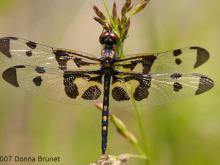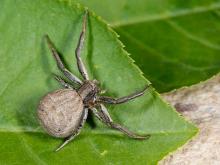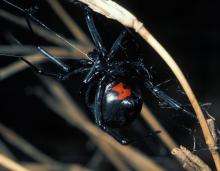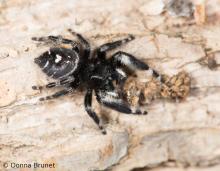Land Invertebrates
Media

Species Types
Scientific Name
Species in the suborder Anisoptera
Description
Like damselflies, dragonflies have long bodies, two pairs of long, membranous, finely veined wings, and predaceous aquatic larvae. Dragonflies typically hold their wings stretched outward, horizontally.
Media

Species Types
Scientific Name
Xysticus spp.
Description
Missouri has several species of ground crab spiders in the genus Xysticus. They are usually dull gray or brown with brown, white, or yellow markings. They typically live under bark or on the ground in leaf litter.
Media

Species Types
Scientific Name
Gea heptagon
Description
The heptagonal orbweaver, Gea heptagon, builds its circular webs in vegetation only a few feet off the ground. When disturbed, it drops instantly to the ground below and turns a drab brown.
Media

Species Types
Scientific Name
Leucauge venusta
Description
The orchard orbweaver is a small, colorful, greenish, delicate spider that makes circular webs in low bushes and damp woodlands. It typically hangs in the middle of its web, its back to the ground.
Media

Species Types
Scientific Name
Mecaphesa spp. and Misumessus spp.
Description
Foliage flower spiders are two genera of crab spiders. They are generally smaller than other crab spiders, and their carapaces, abdomens, and legs are spiny.
Media

Species Types
Scientific Name
Anoplophora glabripennis
Description
An unwanted arrival from Asia that's now living in parts of the United States, the Asian longhorned beetle could destroy millions of acres of American hardwoods. Report any sightings immediately.
Media

Species Types
Scientific Name
Lepisma saccharina, Thermobia domestica, and other species
Description
Silverfish are known worldwide, since they commonly live in our homes. There are a number of species in this family of insects, including the common silverfish and the firebrat.
Media

Species Types
Scientific Name
Latrodectus mactans and Latrodectus variolus
Description
The glossy, black-bodied female black widow spider has distinctive red spots on the underside of the abdomen. Only the female can inflict a potentially dangerous bite. The small, seldom-seen male is harmless.
Media

Species Types
Scientific Name
Nearly 250 species in North America north of Mexico
Description
A wolf spider doesn't spin webs to catch its prey — it runs it down like a wolf! Spiders in this family have long legs and are usually gray, brown, black, or tan with dark brown or black body markings (especially stripes).
Media

Species Types
Scientific Name
Phidippus audax
Description
The bold jumper, or white-spotted jumping spider, is fuzzy, makes jerky movements, jumps surprisingly long distances, and doesn't build webs. It usually has a black body with white, orange, or reddish spots on the abdomen.
See Also



Media

Species Types
Scientific Name
Cisseps fulvicollis
Description
The yellow-collared scape moth is more often “orange-collared.” And whether you think it looks more like a firefly or a wasp, it’s still a moth!
Media

Species Types
Scientific Name
Nearly 150 species in North America north of Mexico
Description
Slim, delicate plume moths are instantly recognizable by their T-shaped silhouette, long legs, and muted shades of tan and brown. It can be hard to separate the various species.
Media

Species Types
Scientific Name
Pyrrharctia isabella
Description
Not many people know the adult Isabella tiger moth when they see one, but we’re all acquainted with its caterpillar, the woolly worm, or woolly bear.
About Land Invertebrates in Missouri
Invertebrates are animals without backbones, including earthworms, slugs, snails, and arthropods. Arthropods—invertebrates with “jointed legs” — are a group of invertebrates that includes crayfish, shrimp, millipedes, centipedes, mites, spiders, and insects. There may be as many as 10 million species of insects alive on earth today, and they probably constitute more than 90 percent all animal species.





















